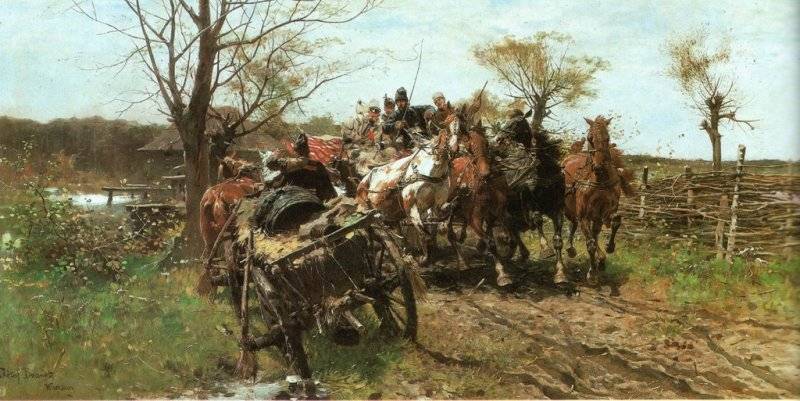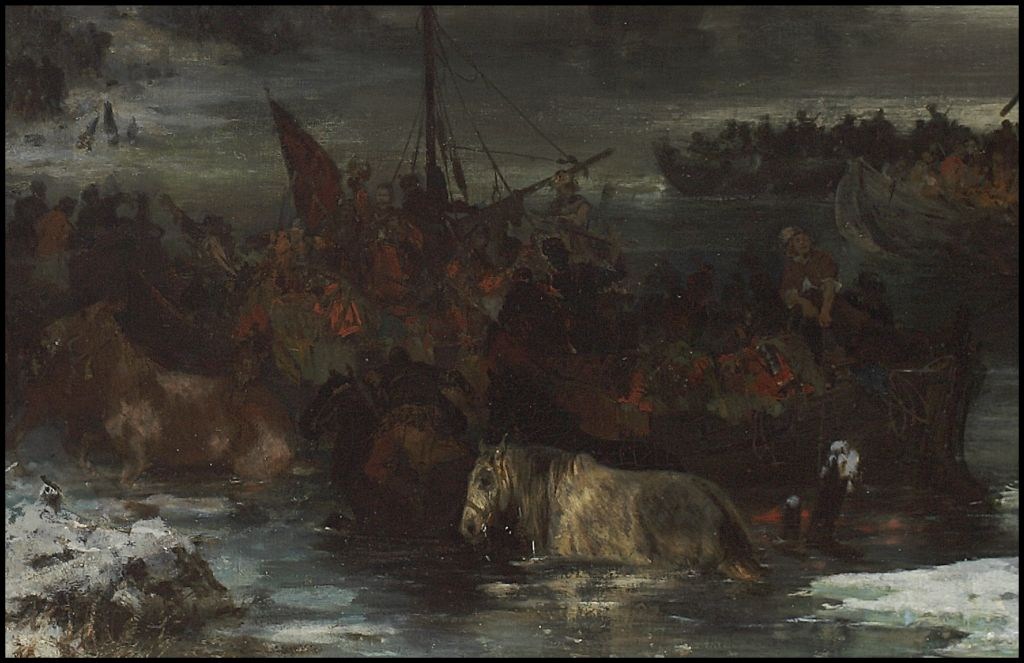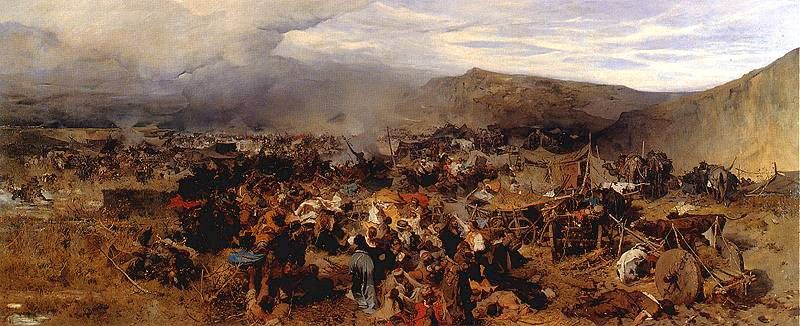Pocket square 'Cossacks Wedding' Brandt
Józef Brandt was a painter, acclaimed for his military art. Throughout the second half of the 19th century, he was the leader of a Polish artistic colony in Munich. He was born in 1841 in Szczebrzeszyn, and died in 1915 in Radom.
He was born into well-known and wealthy family of doctors in Warsaw. His grandfather, who was a professor at the University of Warsaw, was ennobled in 1824 as an act of recognition of his scientific work. His first contact with art was through his mother, Krystyna Lesslów, who was a talented amateur painter, probably taking after her father, Fryderyk Albert Lessl, who was a famous architect. She was the first person to give Józef drawing lessons. After her husband died in 1846, she and her five-year-old son moved in with brother, Stanisław, on his Grzmiące estate near Radom. She also often visited nearby Konary, which belonged to her brother-in-law, Adam Helbich.
In the autumn of 1860 he returned to Warsaw and soon after left with Kossak for Ukraine and Podolia. His first encounter with local nature and lifestyle had a tremendous impact on his future work and artistic interests. His fascination with Ukraine was clearly visible in the works with which he debuted at an exhibition organised by the Society for the Encouragement of Fine Arts in 1861. At first, he painted almost exclusively watercolours under Kossak’s supervision and in Kossak’s characteristic style.

In 1862 Brandt left to study in Munich. He spent some time as an apprentice in Alexandr Strähuber’s workshop and later he attended composition class taught by Karl Piloty in the Academy of Fine Arts. Starting in May 1863 he worked in the atelier of Franz Adam, an outstanding military art painter, who played a vital role in shaping the young artist’s talent. For some time he was also a regular guest at Teodor Horschelt’s watercolour workshop, where he had a chance to familiarise himself with a huge collection of old weapons and military equipment, which proved to be of great help while painting historical military paintings. Due to Franz Adam’s support, he quickly found his place among artistic elite of Munich. Of course, his own skill played a vital role in his acceptance too. For example, his painting Chodkiewicz in the Battle of Khotyn, which was presented at Exposition Universelle de Paris in 1867, sparked an interest among French critics and public, and it was also well received by the German press.
Another example of his early acclaimed paintings is Return from Vienna – Rolling Stock, which was bought for the personal collection of Austrian Emperor Franz Joseph I. The critical reception that he received and high interest from art collectors were important factors in his decision to stay permanently in Munich. Establishing his own workshop in 1870 elevated him to the title of the leader of the Polish artistic colony in the capital of Bavaria. He often helped young artists arriving in Munich, both artistically and financially.
In around 1875 he founded an informal art school in his atelier, where mostly young Poles learned the basics of painting. After marrying in 1877, he spent every summer in his wife Helena Pruszakowa’s estate in Orońsk near Radom. He also often visited Ukraine. The place was an inspiring one, as he often brought back numerous drawings and sketches, and also many historical artefacts, which after his death were to be inherited by the Polish nation.
Brandt reached his highest artistic form in the 1870s and 1880s. After the presentation of Battle of Vienna during the World’s Fair in 1873 he was awarded Order of Franz Joseph. In 1875 he was designated to be a member of Academy of Fine Arts in Berlin, and in 1878 he got a honorary professorship in the Bavarian Academy. Furthermore, in 1881, he was awarded the Order of Saint Michael. Brandt was among the social elite of Munich, and he was a friend of the prince regent Luitpold. The capstone of his career in Munich was 1892, when he received Order of Merit of the Bavarian Crown. With that honour he was ennobled and received the title of Ritter. Even though his paintings were not quite on par with his earlier creations, his works were still extremely popular. Brandt himself also still enjoyed numerous honours.
In 1890 he became a member of the jury of the World’s Fair. He also received many more medals: the gold medal in 1891 in Berlin for The Song of Victory, the Order of Isabella the Catholic in 1893, and the Bavarian Order of Maximilian in 1898. In 1900 he became an honorary member of the Academy of Fine Arts in Prague. Before that, in 1894, he was asked to replace the late Henryk Rodakowski as director of the School of Fine Arts in Kraków, but he did not accept the position. Although he was recognisable around the world, he did not forget about his homeland. He regularly sent his works to appear at various exhibitions organised in Poland, especially by the Society for the Encouragement of Fine Arts, as he was a member from 1874, and the Kraków Society of Friends of Fine Arts.

With liveliness and a certain zest Brandt managed to resurrect the past of the Commonwealth on his canvas. Ideal knights in epic settings, Cossacks, Tatars, jaunty gentry, and brave hussars were all painted with the lush greenery of Ukraine and Podolia. But he didn’t only paint the military. Among other things, he portrayed everyday village life, marketplace scenes, and horses. He also created hunting scenes and genre paintings inspired by Ukrainian Dumkas, called Zaloty, By the Well or Cossack and a Girl. He also took inspiration from literature, from authors such as Wincenty Pol, Kajetan Suffczyński, and Bohdan Zaleski. He also highly valued the notebooks of Jan Chryzostom Pasek and Wojciech Dembołęcki. His first watercolour and oil paintings still show strong inspiration from his mentor and friend, Juliusz Kossak, such as similar horses, hunting scenes or battles and skirmishes. In these works, aside from stylistic inspirations, one can also see technical similarities to Kossak, such as strong contours, and pale, similar colours.
His artistic maturity starts to show as early as in 1863 in March of Lisowczycy or 1866’s Servant Leading a Horse During the Battle. They both show effortless and natural composition that includes complicated perspective devices in figures of horses and men, precise contouring and harmonious colour palette.
The capstone of his studies under Franz Adam is undoubtedly Chodkiewicz in the Battle of Khotyn. It’s an artistic memorial of the successful defence of Khotym against the Ottoman Empire in 1621, which foreshadows epic military scenes, such as Battle of Vienna from 1873 or Retaking of Jassyr (1878). In these vast horizontal scenes Brandt managed to create the illusion of battle noises, sudden emotions, and the dynamics of fighting people and running horses.
One of his best works strays away from this style. Czarniecki by Koldynga, painted in 1870, shows an episode of the Campaign of Jutland led by Stefan Czarniecki in 1658. It is different from his other paintings, because here we can feel a serious tone of contemplation. This time, the historical event isn’t the background for some effective anecdote, but rather inspires to purely artistic expression, which reveals itself in the simplicity, harmony, and discretion of this painting. In the central point of the painting we see some soldiers, trying to get from their ships to the snowy shore. Its gloomy nature is extremely important in this picture, at cloudy skies in a misty, damp atmosphere of winter dawn create an unwelcoming scene, which emphasises the difficulties this warband had to undertake.

The ability to suggest acoustic experiences with the use of paint was characteristic to Brandt. This aspect of his paintings, undoubtedly stemming from his musical talent, is visible especially in paintings such as Greeting the Steppe (1874), which is often replicated and sometimes known as The Song of Victory; Mother of God from 1909, or Cossack’s Wedding, 1893, of which a few different versions were painted. All these pieces follow the same outline – a virtually unending steppe, under a clear, blue sky, a wedding procession, or triumphant cossacks/knights go down the road, singing, playing various instruments, and cheering. Banners and flags moved by the wind, windswept horse manes and guns being fired only strengthen acoustic effects that are a vital point in expressive nature of these paintings.
- fabric: 100% silk
- size: 40 x 40 cm
- handrolled edges
- Paint: Cossacks Wedding
- Panter: Józef Brandt
- Source: Upper Silesia Museum in Bytom









